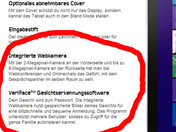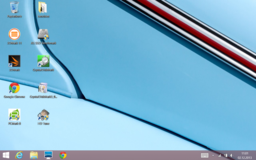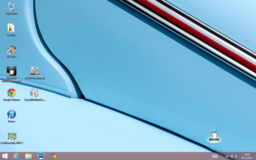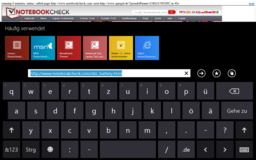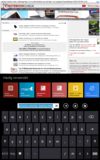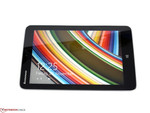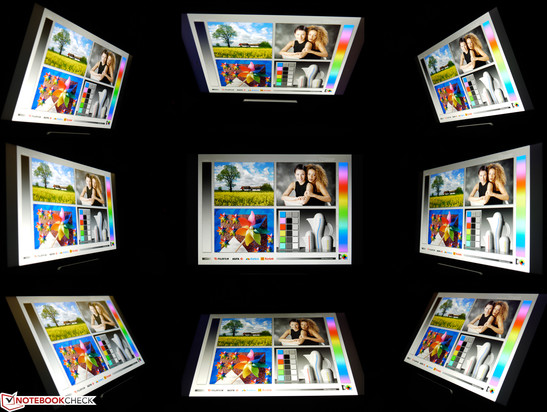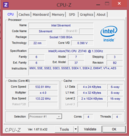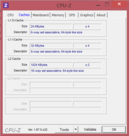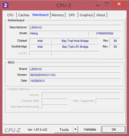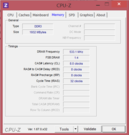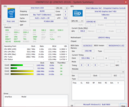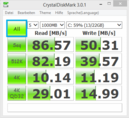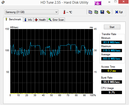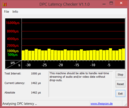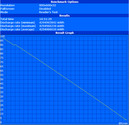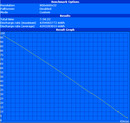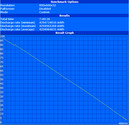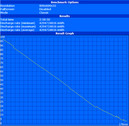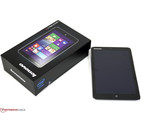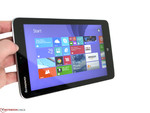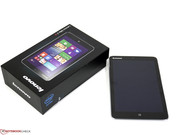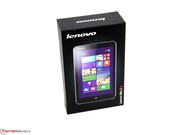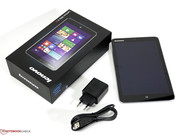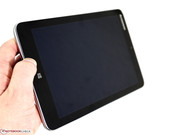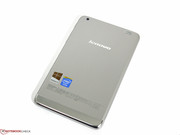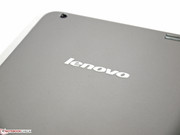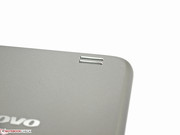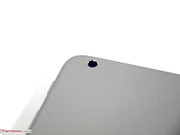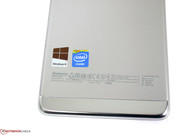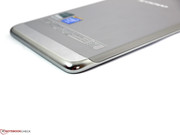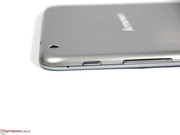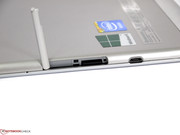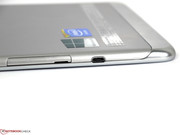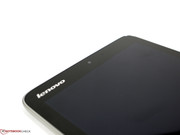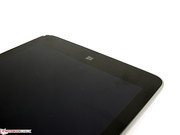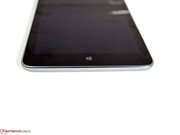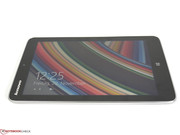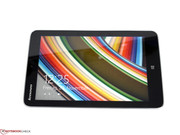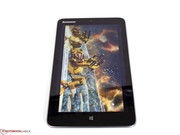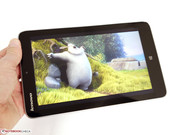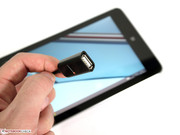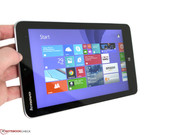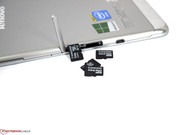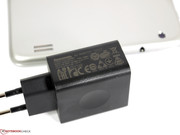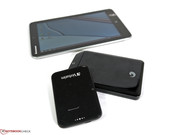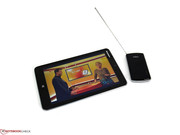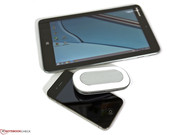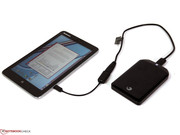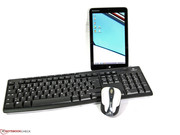Review Lenovo Miix 2 8 Tablet

For the original German review, see here.
Up until now, tablets with the Windows operating system have eked out their existence in the shadow of the dominant Android and iOS models. The problem has been two-fold: Firstly, the Windows operating system has generally demanded too much of the hardware. Secondly, there have been very few processors that are high-performance and still frugal with their energy. Things have changed on both accounts recently. Windows is now more conservative with its resources, and Intel's new Bay Trail Atom processors have supposedly solved the performance vs. energy problem. The Lenovo Miix 2 8 is one of the first devices to belong to this new class and to open up new possibilities in the realm of mobile computing. Our test device is equipped with Intel's Atom Z3740 CPU, 2 GB of RAM, 32 GB of internal flash storage and an 8-inch IPS display. The current version of Windows 8.1 32-bit serves as the operating system, and a full version of Microsoft Office Home & Students completes the package.
Case
At a weight of 340 grams (0.75 lbs), the handy 8-inch tablet is very light and feels comfortable in your hands. Measuring 216 x 132 x 8 millimeters (8.5 x 5.2 x 0.3 inches), its dimensions are only slightly different from the Apple iPad Mini Retina's. The Lenovo lettering on the front side and the Windows sensor key's position indicate that the manufacturer anticipates the tablet will be used predominantly in portrait format. The back side of the case has a metallic look and is lightly etched, giving it a comfortable grip. Fingerprints are less visible on this material than on models with smooth surfaces. With pressure and twisting, the case buckles a little, but all in all, it is fairly stable. The case certainly is not as sturdy as the iPad Mini's or the Surface 2's, however. There is a visible slit between the back side of the case and the display frame. The size of the slit is not quite even all around, and it changes its width when light pressure is applied. We are not so fond of the sticker-like feel of the Lenovo logo either, nor the various adhesive labels on the back side of the device. These all stick out from the back surface and have a slightly uncomfortable feel compared to the pure metallic backing, especially when you are using the tablet in landscape mode. We would have preferred to see these labels either engraved or printed onto the case material.
Connectivity
In terms of connections, the Miix 2 8 offers just a combined microphone/headphone jack, a Mini USB 2.0 port and a MicroSDXC card reader. The tablet does not have any connection for transferring monitor output to an external screen. The memory card slot hides beneath a plastic cover, while the USB port remains permanently open. We tested various memory cards to see how quickly they transfer data to Lenovo's tablet. No card ever exceeded a read speed of 23.9 MB/s or write speed of 15.4 MB/s. It seems that the card reader is at fault for this limit, as the same memory cards achieved considerably better results in the ThinkPad X240 (see image). The tablet had no problem recognizing the external Seagate GoFlex hard drive we connected via the USB port using an adapter. It reached a transfer rate of 37.8 MB/s, which is a good number, considering it is hardly possible to transfer faster than that over a USB 2.0 port. This represents the Miix 2 8's fastest means of moving data. Since the USB port also serves as the connection for the power supply, it is not possible to charge the tablet and transfer data at the same time.
Communication
The 2-megapixel webcam integrated into the front side of the device enables the user to make video calls in well-lit rooms, where its image quality is acceptable. The less light in the tablet's environment, the duskier the image becomes. Contrary to what Lenovo's advertisements lead you to believe, you do not feel at all like you and your conversation partner are in the same room. According to Lenovo's product page, the camera on the back of the device has a resolution of 8 megapixels, but the spec sheet reads 5 megapixels. The manufacturer seems a little confused here. Compared to the front camera, the back camera offers somewhat better image quality. As long as the image being photographed is easy enough to capture, it can take reasonably good snapshots outdoors in the sun or in well-lit rooms, but it falls short of the iPhone 4s' camera quality. The camera's image noise, color accuracy and light sensitivity are all visibly worse. Also, we do not quite understand how Lenovo arrived at their idea that the camera has a resolution of 8 or 5 MP; the tablet took our test photos at a resolution of 2560x1440 pixels. That corresponds to about 3.7 MP, and we found no way to change that in the settings. Neither did we find the Veriface face-recognition software that Lenovo advertises as a feature on their Miix 2 8 -- not on the device itself, nor on the download page of their website.
Our test device has an Ethernet module (802.11a/b/g/n) from Broadcom at its command. The module's reception range and reception quality are average. At various distances, the signal strength registered at around the level of an Atheros AR9485WB (Asus N76VZ) or a first generation iPad. We did not experience any unusual breaks in the connection, long searches for networks or noticeably low transfer rates. External devices like smartphones, mice and keyboards can be connected to the tablet via Bluetooth 4.0.
Accessories
Lenovo currently offers very few accessories for their Miix 2 8. The removable cover also serves as a stand and is supposedly available in various colors. Similar to many pens from third-party distributors, the capacitive pen does not have any digitizer function and simply imitates finger input, but it should help the user to be more exact and accurate with their input for desktop applications. The pen can be stowed away in the flip cover. On their product page, Lenovo also advertises a Folio case that serves as both a folding keyboard dock and a cover. We could not find any information on its price or availability. The generous supply of further software tools usually included with Lenovo devices is nowhere to be found on the Lenovo Miix 2 8. Here you will only find an app to assist you in accessing Lenovo's app store. Currently, the support on Lenovo's homepage consists of just a few drivers.
Warranty
Lenovo offers the Miix 2 8 with a 24-month manufacturer's warranty. As of the publication date of this review, we have not found any compatible warranty extensions, but according to Lenovo, it should be possible to purchase a warranty to cover up to 3 years.
Input Devices
Multitouch Screen
Unlike the Dell Venue Pro 8, the Miix 2 8's capacitive touchscreen does not have any digitizer function. Pen input is only possible with capacitive universal models that use rubberized tips to imitate finger input while offering more precision than a finger. The tablet's reactivity is good overall, though you occasionally need to use a little pressure to get the touchscreen to recognize your command. Its accuracy is also good, but not quite precise enough to consistently let you work in the Windows interface fluidly. Neither of these problems arise within the tile interface or adapted apps, but in regular Windows applications with small buttons, scroll bars and icons, operation is a little more difficult. Changing the zoom level can help here, but it lessens the available workspace. At a zoom level of 125%, it is much easier to work with the familiar Windows interface.
Virtual Keyboard
In landscape format, the Miix 2 8's virtual keyboard is quite large and offers relatively big keys. Despite small differences in layout, with a little familiarization it is just as easy to use as the keyboards on iOS or Android operating systems. The keyboard area can be split and somewhat tailored to the user's preferences. In portrait format, the keys are rather small and hard to hit accurately without earnest concentration. You can connect an external keyboard and mouse using Bluetooth, or via the USB port (with an adapter) if you are in a pinch.
Display
The Lenovo Miix 2 8 is equipped with an 8-inch IPS display that has a resolution of 800x1280 pixels in portrait format. The tablet can of course be used in landscape format, though the webcam and Windows buttons are then located on the sides of the device rather than the top and bottom. As is true of most tablets, the display surface is very reflective. At 188 dpi, the screen's pixel density is fine enough that it is very difficult to see the individual pixels. Icons, symbols and lettering are usually large enough that you can read them without changing their size. When it comes to finger operation, on the other hand, it is often necessary to enlarge them. We recommend zooming to 125%.
| |||||||||||||||||||||||||
Brightness Distribution: 88 %
Center on Battery: 401 cd/m²
Contrast: 668:1 (Black: 0.6 cd/m²)
ΔE ColorChecker Calman: 3.5 | ∀{0.5-29.43 Ø4.83}
ΔE Greyscale Calman: 2.42 | ∀{0.09-98 Ø5.1}
43% AdobeRGB 1998 (Argyll 1.6.3 3D)
46.76% AdobeRGB 1998 (Argyll 3D)
66.9% sRGB (Argyll 3D)
45.26% Display P3 (Argyll 3D)
Gamma: 2.56
CCT: 6422 K
The maximum display brightness ranges from 369 cd/m² to 417 cd/m². We registered the brightness at 388.9 cd/m² in the middle of the screen, and the brightness distribution was 88% similar across the panel. The screen's lowest brightness level measured 51 cd/m², and about ¾ of the way up the scale it came to 158 cd/m². We used this brightness level for our WLAN and video tests. Thanks to the panel's high maximum brightness, the display image is still visible outdoors. However, the screen's reflective surface produces overlapping mirror images that make it hard to see the actual display content. Even at maximum brightness, realistically the screen will not shine brightly enough to overcome the reflections. In direct sunlight, you will not be able to make out anything besides your own reflection. But that is true of almost every tablet on the market and simply a fact of life.
At 668:1, the display's contrast is average. Black image content could look darker, especially when it comes to films, games and photos. The panel covers about 63% of the sRGB color space. Out of the factory, the display is fairly well calibrated; we measured average DeltaE 2000 values of 3.5 for mixed colors and 2.4 for the grayscale. After calibration, overall these results are substantially better still. While the panel comes quite close to the ideal in many color ranges, the basic colors blue and magenta still deviate significantly from the norm. Due to its greater color space coverage, the Apple iPad Air does visibly better here, but the Microsoft Surface Pro 2 is similarly limited in its ability to display colors accurately.
The IPS panel's viewing angle stability is very good -- the screen content looks normal from every angle. In general, the screen's colors remain stable; the only exception is a faint yellow shimmer in dark environments when the screen is slanted from above. The display brightness is not quite so stable and varies a somewhat inconsistently depending on the position of the display. However, this is hardly noticeable with normal use.
Performance
The performance components at work in the Lenovo Miix 2 8 are almost identical no matter which version you purchase. The eMMC Flash storage medium is the only wild card, ranging from 32 GB to 128 GB. Currently, the only models available have the smallest amount of storage. Intel's new Atom generation Bay Trail serves as the CPU. Bay Trail processors can also carry the names Celeron or Pentium in some entry-level notebooks. Intel's HD Graphics (Bay Trail) is responsible for graphics output and squeezes its graphics memory out of the 2 GB of LPDDR3 working memory. At the tablet's starting price of 300 Euros (~$410), Windows 8.1 and Microsoft Office Home & Students always come as part of the package.
Processor
The new Bay Trail processor generation has four cores at its command. Using Turbo Boost, the cores can increase their base clock rate to adapt to the performance demands. Unlike on the Clover Trail platform, Hyperthreading is no longer supported -- though with the new processor's four cores, that is not too hard to swallow. Our Intel Atom Z3740 clocks at 1.3-1.8 GHz, is manufactured at 22 nm, and can handle a maximum of 4 GB of RAM. With a TDP (Thermal Design Power) of less than 4 Watts, this CPU is especially suited for use in thin and flat devices like tablets, as the manufacturer certainly should not rely on active cooling in a device with that kind of build.
In one of our CPU benchmarks, Cinebench R10 32-bit, compared to the preceding Atom processor model the CPU's performance increased by 50 to 100%. Even the Intel Core i3-3229Y in the Acer Aspire P3 loses to this CPU in the multithread test. Converting audio in iTunes, we registered a speed of 13.9x -- much faster, for example, than the AMD Fusion E350-CPU. In everyday use, the Intel Atom Z3740 CPU is quick enough to carry out many tasks fluidly and provides a smooth work environment under Windows 8.1. Most of the shortcomings we encountered had more to do with conceptual problems than with the operating system or the processor.
Under sustained full load in battery mode, we did not observe any drop in performance. The results from the smattering of tests we reran in this state were almost identical to the results we originally obtained.
| Cinebench R10 | |
| Rendering Single 32Bit (sort by value) | |
| Lenovo Miix 2 8 | |
| Lenovo IdeaTab Miix 10 64GB | |
| Acer Aspire P3-171-3322Y2G06as | |
| Rendering Multiple CPUs 32Bit (sort by value) | |
| Lenovo Miix 2 8 | |
| Lenovo IdeaTab Miix 10 64GB | |
| Acer Aspire P3-171-3322Y2G06as | |
System Performance
The system performance is very good for a tablet and contributes to the Miix 2 8's potential to fit the bill for a variety of uses. The tablet's limiting factors here are mostly its meager connectivity options and relatively low display resolution. A separate charging port, HDMI and USB 3.0 could have lent the Lenovo Miix 2 8 more flexibility. Still, you can tackle a good range of tasks with the little 8-inch device.
A full version of Microsoft's Office Home & Students comes as part of the package and does not overtax the system at all. We also played Full HD videos in full resolution without any problems -- though seeing as the tablet is missing an HDMI output and the screen resolution is not stellar, storing Full HD videos is a waste of space. The performance is also good enough to watch TV via a DVB-T stick. Here, too, the dearth of connectivity options limits the user more than anything. A stick on a Micro USB adapter cable is rather cumbersome, and realistically you will only want to use it in a stationary setting. Ethernet-based systems like the Elgatos Tivizen DVB-T Hotspot are much more comfortable here. This device has its own battery, so it emits a TV signal for several hours without needing to connect to a power socket. The Lenovo Miix 2 8 has no problem whatsoever with video chats, Internet or casual games. Under certain conditions, you can also edit images or videos, if the question is performance. However, the tablet's limited memory puts a damper on this application as well. Processing large image or video files can push the performance closer to its limits, though inserting a card into the memory card slot does not do any harm here.
The tablet gathered a total of 5495 points in PC Mark Vantage and 2505 points in PC Mark 7. With these scores, our review device is more or less on par with the similarly equipped 10-inch Asus Transformer Book T100TA.
| Geekbench 2 - 32 Bit - Total Score (sort by value) | |
| Lenovo Miix 2 8 | |
| Asus Transformer Book T100TA-C1-GR | |
| Acer Aspire One 725-C7Xkk | |
| Google Nexus 7 2013 | |
| Sunspider - 1.0 Total Score (sort by value) | |
| Lenovo Miix 2 8 | |
| Apple iPad Air 1 2013 | |
| Google Nexus 7 2013 | |
* ... smaller is better
| Browsermark - --- (sort by value) | |
| Lenovo Miix 2 8 | |
| Apple iPad Air 1 2013 | |
| Google Nexus 7 2013 | |
| PCMark Vantage Result | 5495 points | |
| PCMark 7 Score | 2505 points | |
Help | ||
Storage Devices
The internal eMMC mass storage from Samsung reached up to 86 MB/s in our sequential read test and 50 MB/s in our write test. HD Tune even showed a maximum of 119 MB/s in data transfer. In absolute terms and compared to current SSDs, this is not a particularly fast speed, but it is certainly adequate for use in a tablet. Thanks to the quick access time of about 1 ms, programs and files always open quickly, and subjectively it feels like the system works fluidly. Things get a little slower when the tablet processes large files and the working memory approaches its limit. Realistically, this is likely to be a rare occurrence, as the 32 GB of internal storage space is not large enough to hold many unwieldy files. After our first start-up, we only had 9.65 GB of free space at our disposal.
The user can expand the tablet's memory with MicroSD/SDHC/SDXC cards. As we mentioned in the Connectivity section of this review, the system recognized a 64 GB SDXC card from Transcend without a problem. We tried using the file formats exFAT and NTFS. At 23.9 MB/s reading and 15.9 MB/s writing, their transfer rates were middle-of-the-road at best. It would be unrealistic to expect better write and read speeds from different memory cards, as our MicroSDXC card delivered much better results in Lenovo's ThinkPad X240.
Graphics Card
The integrated Intel HD Graphics (Bay Trail) clocks at 667 MHz and uses the RAM available in the shared memory system as its graphics memory. Its 3D performance is minimal, so the tablet is not fit for use with 3D software that demands a lot of graphics power. But for the tasks one generally performs on a tablet, the graphics card should be more than adequate. The device plays Full HD videos smoothly, and the Internet and Microsoft Office suite do not require more graphics performance than videos. The integrated Atom graphics processor now also has Intel's Quick Sync Video at its command. The new feature does not enhance the performance as much as it does in Core i processors, but depending on the video format, it can convert film material very quickly. It would be unthinkable to use this in conjunction with the CPU, as the tablet would be rendered unusable for quite some time
| 3DMark 06 1280x800 Score | 2087 points | |
| 3DMark 11 Performance | 212 points | |
| 3DMark Ice Storm Standard Score | 16401 points | |
| 3DMark Cloud Gate Standard Score | 1236 points | |
Help | ||
Gaming Performance
In terms of gaming, the tablet's limited variety of input options is rather restrictive. An external mouse and keyboard are basic requirements for many games, and both of these would need to be connected to the Miix 2 8 via Bluetooth. The system recognized neither an Xbox 360 controller nor an unbranded device mimicking a PS3 product when we tried to connect them via a Micro USB adapter. If you do manage to get all your input devices set up, you can at least play less demanding games at low settings fluidly. In the long run, though, the small screen size and difficult hardware setup are likely to get old fast.
| low | med. | high | ultra | |
|---|---|---|---|---|
| World of Warcraft (2005) | 48 | 26 | ||
| Dirt Showdown (2012) | 28 | |||
| Torchlight 2 (2012) | 42 |
Emissions
Temperature
The Lenovo Miix 2 8 does not have an active fan; it is passively cooled. We measured a maximum temperature of 43 °C (109.4 °F), but the device only grew this warm after an extended period under full load. With regular use, the tablet will almost never reach this temperature. Even if it does, it is not a serious problem -- the case grows warm to the touch in some places, but it certainly never becomes hot enough to burn the skin.
(±) The maximum temperature on the upper side is 42.1 °C / 108 F, compared to the average of 33.7 °C / 93 F, ranging from 20.7 to 53.2 °C for the class Tablet.
(±) The bottom heats up to a maximum of 43 °C / 109 F, compared to the average of 33.2 °C / 92 F
(+) In idle usage, the average temperature for the upper side is 26.4 °C / 80 F, compared to the device average of 30 °C / 86 F.
Speaker
The speaker on the backside of the device produces a relatively good sound, though it cannot hide the fact that it is a little heavy on the high tones and lacking in bass. The volume has 50 levels reaching to 100, each 2 apart, but its maximum volume is rather low. Still, the sound never distorts and you can hear it well if you are close to the device. You can connect headphones or external speakers via USB, the 3.5 mm jack or Bluetooth.
Energy Management
Power Consumption
Thanks to the tablet's frugal components, its power consumption is very low under every level of load. Depending on how heavily the device is loaded, we measured a power consumption rate of between 1.2 and 10.3 Watts on the mains side. Such low consumption rates can be good preconditions for a long battery life, though the tablet's integrated lithium-polymer battery only has a capacity of 17.5 Wh. Since the power supply has a power rating of only 10.4 Watts, it cannot supply ample energy when the tablet is under full load and charging. When the device is turned off and charging, it draws about 10.3 Watts -- almost the power supply's nominal capacity.
| Off / Standby | |
| Idle | |
| Load |
|
Key:
min: | |
Battery Life
The results of our battery life tests show that Windows tablets need no longer fear their Android and iOS competition. In the Battery Eater Reader's Test (maximum run time, wireless modules deactivated, minimum display brightness (51 cd/m²), maximum energy-saving settings), the tablet reached a run time of about 15 hours. In the WLAN test (brightness set to 158 cd/m², wireless modules on), the Miix 2 8 still ran a good 7 hours and 34 minutes. The Full HD film we play for our video test (158 cd/m², wireless off) ran for about 8 hours straight. In the Battery Eater Classic Test (maximum brightness, everything on), the Lenovo Miix 2 8 chugs on for about 3 hours. We performed all our tests in the tablet's balanced profile, as there are no alternative energy profiles available.
Verdict
Yes, the Lenovo Miix 2 8 really is a small, 8-inch tablet complete with Windows 8.1, a solid IPS panel and a full version of Microsoft Office 2013 Home & Students. The overall concept is well executed, yielding a device that is appealing in many respects. It is small, it feels good in your hands, it has a long-lasting battery, and it reacts fluidly to input. Then of course there is the fact that it is fully compatible with the rest of the Windows world.
In terms of concept, there are several downsides to the Lenovo Miix 2 8, and it would be a good idea to consider them carefully before purchasing one of these devices. The only Micro USB port serves as the connection for both data transfer and charging. The card reader's transfer rates are no more than middle-of-the-road, and at just 9.65 GB, the internal memory is fairly scarce. In addition, the device has no connection for monitor output, and the two webcams are just barely good enough for use in well-lit environments.
If you can live with these limitations, you are looking at one of the cheapest Windows 8 tablets on the market -- and that with a good display, very good battery life, and to top it off, a full Microsoft Office suite.












